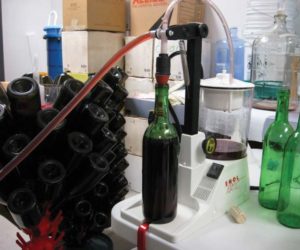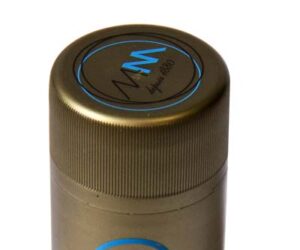Q
I use wood chips in many of my wines, both from kits and from grapes. But when it is time to rack, they always create problems plugging my hoses. I found some inexpensive “hop socks” at a homebrewing store. You just tie a knot and toss it in. The sock is big enough to allow the chips to be free in the bag, not packed together. I just take it out, squeeze the juice, and throw it away. This eliminates the hose plugging. But does this allow the oak chips to work the same as if I just pour them in the fermenter loose?
Bob Kyle
Michigan
A
I love your innovation. A “chip sock” can be a real boon to winemakers. In fact, I mention using one in The Winemaker’s Answer Book where I suggest using a nylon stocking as a handy and cheap DIY bag. A small food-grade nylon bag, especially when it’s not as delicate as a nylon stocking, is an even better bet. Washable, re-useable, and more robust, this kind of submergible container for those pesky little chips definitely leaves less of a mess.
You’re right to question whether the extraction dynamics are different as a chip sock will keep all the chips together in one place rather than floating freely (or sinking) in the liquid. I actually prefer using a sock or some kind of bag rather than just having chips float loose on the surface. I believe that you get more of the wood submerged overall and it’s cleaner and safer for the wine. Basically, I consider loose, floating chips like little islands for bacteria and mold to possibly grow on. The underside of that chip will be wet and in contact with the wine; the low pH and lack of oxygen on the underside will help to keep spoilage organism growth under control. On the sunny topside, however, there’s no low pH benefit and it’s possible there’s quite an oxygen-rich environment if the container is not topped. That can easily become a recipe for trouble if not handled properly.
Furthermore, if you just have loose chips and a completely topped container like a carboy, most of the chips will just be floating up in the neck of the carboy, not really mixing and mingling with the rest of the wine. The best-case scenario is to use a chip bag but to submerge it with weights so it can float around the middle to bottom of your container. Depending on the size of your container and the chip bag (and the number of oak chips) anything from a few marbles to a few stainless steel tank fittings or washers could do it. If you are large enough to ferment in tanks, many tanks either have (or can be ordered) with D-rings welded inside. These are handy places to tie off your chip bags so you know they’ll always be safely submerged.
Q
How many bottles of wine can be produced per acre (0.405 hectare) of winegrapes?
Mark Cave
Napa, California
A
As one of my vineyard manager co-workers famously says just about every other day whenever he answers a question like this, “It depends.” However, before I dive into all of the prevarications and provisos, here are some basic conversion assumptions for grape growing and wine production. These are handy facts to memorize so hopefully you can whip out the math at the drop of a hat when asked, or at least calculate them for yourself on the fly with (or without!) the help of your smartphone.
Let’s start with certain numbers which winemakers can count on.
Basic Conversions
• 1 bottle = 750 mL or 0.750 L
• 12 bottles = 1 case
• 1 case = 9 L = 2.42 gallons
• 1 barrel = 59 gallons = 223 L
Now let’s move onto some less certain numbers that will depend largely on where and how you farm and how you produce your wine.
Estimated vineyard yield
• High-production/low-value wine grapes: 7-10 tons/acre
(15.6 -22.4 metric tons/hectare)
• Lower-production/higher-value wine grapes: 2-4 tons/
acre (4.5 -9 metric tons/hectare)
I would say any home winemaker growing a hobby vineyard for themselves will most likely fall in the below (smaller yield) category.
Estimated Home Winery yield
• Red: 165 gallons/ton (0.69 L/kg)
• Whites or Rosés: 170 gallons/ton (0.71 L/kg).
Of course, this depends on so many factors. The smaller the berries, the lighter you press, the smaller-scale and less powerful your press, the lower your yield will be.
Wine Losses During Aging/Processing
Let’s say we should expect 2-4 percent of wine loss over the life of a wine. This loss will be lower with tank-aged stainless steel wines that are quick to bottle and will be larger with longer-aged wines that sit in the barrel and therefore evaporate more wine (the angel’s share) through the barrel over time.
Let’s take a conservative approach and assume you’ll get 3 tons to the acre (6.75 metric tons/hectare) of Cabernet Sauvignon with medium-sized berries and you don’t take a press cut. Your yield at the press will be about 155 gallons/ton (0.65 L/kg). That means one acre (0.405 hectare) of vineyard yields you 465 gallons (1,760 L) of wine. Assume 4% loss over the wine’s lifetime because you do 100% barrel aging. So pre-bottle, that leaves you with about 446 gallons (1,688 L) wine. Divide that by 2.42 and you get 184 cases, or 2,208 bottles of wine. So divide those bottles by your original 3 acres (1.2 hectares) and you get that your one acre (0.405 hectare) yielded you 736 bottles of wine.
You can play with the numbers and see how a swing one way or the other can change the result for better or worse. It’s best to look at all of the above criteria and do your best to put your own personal data into the calculations. If you can keep good records over a few harvests you’ll soon be able to more accurately predict exactly how many bottles you’re getting per acre of your own particular vineyard. Of course, the calculations are easier if you’re buying a specific number of tons from a producer, as opposed to just netting the produce from a certain number of acres. If you can keep your cellar well-humidified, you’ll also lose less volume over time. Each drop is precious, especially for a small-scale home winemaker.
Q
I have Syrah with H2S that I tried to take care of with a copper sulfate addition. After doing bench trials I found a solution but when I went to treat the entire batch I was rushing and ended up with 11 mL of 1% copper sulfate in a 15-gallon (57-L) batch. In the middle of the night I realized it was way too much. I have a 1-micron filter, would that help?
Roger Mattar
Corona, California
A
That’s too bad that you added more copper sulfate than you intended to. Copper is an effective, legal, and ancient (the Romans knew about its curative powers in winemaking) tool for reducing (no pun intended) stinky rotten egg defects. Hydrogen sulfide is often the culprit and ionic copper, delivered in the form of copper sulfate (CuSO4), can often help the problem. We have to be very careful because though copper sulfate is about 25% ionic copper, residual ionic copper has a legal limit in commercial winemaking (0.50 ppm Cu) because too much copper is toxic. It also can markedly change the nose and finish of a wine so that’s why it’s important to do bench trials to find the minimum dose possible that will affect the change you desire.
Luckily, working out the math, and keeping in mind that copper sulfate is only 25% ionic copper if you’ve added 11 mLs of a 1% solution to 15 gallons (57-L), you’re probably right around that legal limit. You may not have to throw the wine away due to it being toxic but you may very well be disappointed in the taste and smell of the wine after the addition. Unfortunately there’s no good way to remove a lot of excess copper once it’s in your wine. Residual copper can decrease over time if your wine is very leesy; I’ve found with monthly lees stirring I once “removed” (due to absorption onto lees) about 0.10 ppm but this is just my own anecdotal experience. You could certainly blend it (do bench trials first) but one of my maxims is never throw good wine after bad. If you do blending bench trials and like the results, however, you could go for it, especially if you have a lot that could use a little copper sulfate itself.







